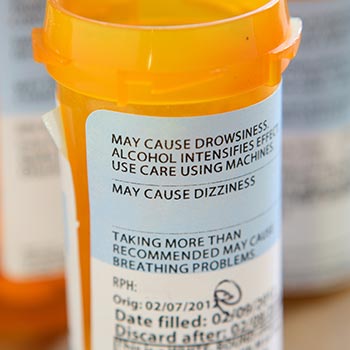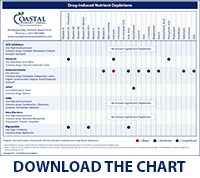
Drugs—can’t live with them, can’t live without them, right? In America, almost 70% of people take at least one prescription medication, and more than half take two, according to a study in 2013 funded by the National Institute on Aging and the Mayo Clinic. These numbers have steadily increased over the past decades. While medications provide relief and treatment for many conditions and disease states, they may come at the price of depriving the body of nutrients. Nearly every medication, including OTC remedies, deplete the body of one or more of its vital nutrients. This brings additional concern considering that many Americans do not have adequate levels of nutrients to begin with. Many reported side effects or even conditions are attributed or related to nutrient depletion. However, with the right information, steps can be taken to avoid nutrient depletion and optimize health!
What are nutrients and why do we need them?
First of all, what exactly are nutrients?
- Nutrients are substances that are essential for growth and maintaining life. They provide energy to cells and play important roles in the makeup of cellular structures, such as proteins.
- Our bodies can synthesize non-essential nutrients (ex. Carbohydrates, fatty acids, some proteins) while essential nutrients (ex. Iron, potassium, vitamin A) need to be acquired by the diet.
Theoretically, eating a balanced diet provides your body with all the nutrients it needs to function. But many factors can interfere with this, including prescription drugs.
How do drugs rob my body of nutrients?
There is no one way that drugs cause nutritional deficiencies. Some act by modifying your behavior, while others act at the cellular level. For example, stimulants such as Adderall or Vyvanse may suppress appetite, which in turn reduces food and nutrient intake. On the other hand, other medications, such as neuroleptics and antidepressants, may increase cravings for unhealthier foods that give your body more work than benefit! At the cellular level, medications act in a number of ways to cause nutrient deficiency. Medications may inhibit nutrient absorption, flush out nutrients by increasing urination, and use them faster by speeding up metabolism. We have outlined the major classes of drugs and potential nutrient deficiencies that may arise as follows.
Nutrient Depletion by Drug Class
 To find the sources and functions of common nutrients, please see next section. Note: Not all medication classes are listed because not all have known significant nutrient depletions.
To find the sources and functions of common nutrients, please see next section. Note: Not all medication classes are listed because not all have known significant nutrient depletions.
Acid-Suppressing Drugs and Antacids
These medications are prescribed to treat heartburn, gastroesophageal reflux disease (GERD) and peptic ulcers
- H2 antagonists block histamine (H2) receptors in the stomach, which are involved in acid production. Blocking these receptors decreases the production and secretion of acid (ex. Ranitidine, cimetidine, famotidine).
- Nutrients depleted:
- Stomach acid is necessary for vitamin B12 absorption.
- H2 antagonists also decrease the absorption of calcium, iron, folic acid, zinc, and chromium
- Nutrients depleted:
- Proton-Pump Inhibitors irreversibly block the last stage of gastric acid production, which is responsible for secreting H+ ions into the gastric lumen. These are the most potent acid-reducing medications (ex. Omeprazole, Esomeprazole, Lansoprazole, Pantoprazole).
- Nutrients depleted:
- PPI’s have been found to block absorption of magnesium and Vitamin B12
- Insignificant amounts of calcium, folic acid, iron, and zinc depletion have also been reported
- Nutrients depleted:
- Antacids neutralize stomach acidity (ex. Calcium Carbonate, Tums, Mylanta, Rolaids)
- Nutrients depleted:
- Neutralizing stomach acid weakens the breakdown of food into its constituent nutrients
- This results in moderate deficiencies in calcium, phosphate salts, and thiamine
- Nutrients depleted:
Antibiotics
Antibiotics are prescribed to treat bacterial infections.
- Penicillins (amoxicillin, ampicillin, penicillin VK) additionally deplete calcium
Fluoroquinolones (ciprofloxacin, levofloxacin, ofloxacin) additionally deplete calcium and iron
Aminoglycosides (gentamicin, streptomycin) create imbalances of calcium, magnesium, and potassium- Nutrients depleted
- Generally, antibiotics deplete nutrients because they not only rid the body of pathogenic bacteria, but also gut microbiota, or the “good bacteria” found in the intestinal tract
- This results in a general depletion of vitamins B1 (thiamine), B2 (riboflavin), B3 (niacin), B5, B6 (pyridoxine), B12, folate, biotin, and vitamin K
- Nutrients depleted
Antidepressants
These medications are prescribed to treat depression, anxiety, Obsession Compulsive Disorder, and eating disorders.
- Selective Serotonin Reuptake Inhibitors (SSRIs) block reuptake of the neurotransmitter serotonin, thereby increasing extracellular levels of the chemical. Serotonin is associated with thoughts of wellbeing and happiness (ex. Citalopram, Desvenlafaxine, Duloxetine, Escitalopram, Fluoxetine, Sertraline, Paroxetine, Venlafaxine).
- Nutrients depleted:
- May cause changes in appetite or cravings that influence nutrients consumed
- Folic acid depletion has been associated with SSRIs
- Nutrients depleted:
Anti-Convulsants
Otherwise known as Antiepileptic drugs, these primarily treat seizures and more recently borderline and bipolar disorders. They work by minimizing abnormal firing of neurons in the brain and preventing the spread of a seizure (ex. Diazepam, Gabapentin, Lamotrigine, Levetiraceta, Valproic Acid/Divalproex Sodium).
- Nutrients depleted:
- Anticonvulsants have been associated with calcium deficiency and bone disease
- While the mechanism is not well understood, the deficiency may be caused by lack of absorption, vitamin K deficiency (which is needed for calcium absorption), and down regulation from lack of neuronal firing
- When your blood has low calcium levels, specialized cells called osteoclasts are activated that release calcium from bones. This raises blood calcium levels but decreases bone mineral density (BMD).
Anti-Hypertensives
While a very diverse class of drugs, antihypertensives work to lower high blood pressure.
- ACE Inhibitors block the Angiotensin Converting Enzyme (ACE) that normally reacts to produce Angiotensin II, a peptide hormone that narrows blood vessels and raises blood pressure (ex. Lisinopril, Benazepril, Enalapril, Ramipril, Quinapril)
- Nutrients Depleted:
- Certain ACE inhibitors bind to zinc in the body. This bound form can’t meet the body’s needs and gradually leads to zinc depletion
- Nutrients Depleted:
- Beta blockers inhibit the action of catecholines (commonly known as adrenaline) by competitively binding to adrenic beta receptors. This prevents the “fight or flight” response and ultimately reduces cardiac output to lower blood pressure (ex. Atenolol, Metoprolol, Propranolol, Timolol, Carvedilol).
- Nutrients Depleted:
- Beta blockers can impede in the biological pathway of coenzyme Q10, which is essential for the production of ATP, the energy for cellular processes
- Blocking adrenic beta receptors also reduces the production of melatonin, which is important for sleep and circadian rhythms
- Nutrients Depleted:
- Angiotensin Receptor Blockers (ARBs) stop Angiotensin II (see ACE inhibitors) from acting by blocking the receptor site (ex. Amlodipine, Candesartan, Irbesartan, Losartan, Telmisartan, Valsartan).
- Nutrients Depleted:
- Magnesium, potassium, and zinc levels may decrease
- Nutrients Depleted:
- Calcium Channel Blockers (CCBs) prevent the entry of calcium to myocardial cells in the heart. This decreases cardiac output and dilates blood vessels (ex. Amlodipine, Diltiazem, Nifedipine, Verapamil).
- Nutrients Depleted:
- No known significant nutrient depletions
- Nutrients Depleted:
- Loop Diuretics cause the kidneys to excrete more salt and water and result in increased urination. This reduces the amount of liquid and pressure in blood vessels (ex. Furosemide, Bumetanide)
- Nutrients Depleted:
- By increasing the volume of water flushed out of the body, nutrients also get flushed out
- The major concern is potassium loss, although magnesium, calcium, and zinc levels may decrease as well
- Nutrients Depleted:
Biguanides
Biguanides are oral antihyperglycemic drugs responsible for improving glucose tolerance in type 2 diabetes patients. They manage the disease by decreasing glucose production, decreasing intestinal absorption of glucose, and improving insulin sensitivity. The most common example is Metformin.
- Nutrients Depleted:
- Metformin reduces the absorption of vitamin B12, which in turn reduces associated vitamins and minerals such as calcium
- Chromium deficiency may occur and contribute to insulin resistance
- Magnesium depletion has also been reported
Cholesterol-lowering Drugs
This class of medications treats hyperlipidemia or high cholesterol.
- Statins inhibit the enzyme HMG CoA reductase, which plays a critical role in cholesterol production. By reducing cholesterol synthesis, the liver can work to remove preexisting LDL cholesterol in the bloodstream (ex. Atorvastatin, Lovastatin, Simvastatin, Rosuvastatin).
- Nutrients Depleted:
- HMG CoA reductase is also involved in the synthesis of Coenzyme Q10, which is essential for energy production in mitochondria. Therefore, Coenzyme Q10 depletion is a serious concern and may result in heart failure, muscle pain and weakness, irregular moods and irritability
- Nutrients Depleted:
Corticosteroids
Corticosteroids reduce inflammation and can be used to treat many different diseases, including allergies, asthma, arthritis, and Crohn’s disease. Generally, they serve in the immune system to block histamine and reduce inflammation (ex. Methylprednisolone, Prednisone, Clobetasol, Triamcinolone).
- Nutrients Depleted:
- Steroids reduce calcium and vitamin D absorption
Hormone Replacement Therapy
These medications are used to treat post-menopausal symptoms by replacing female hormones that are no longer being produced in appropriate amounts.
- Estrogens (ex. Estradiol, Estring, Estrace)
- Nutrients Depleted:
- Conjugated estrogens have been shown to decrease the absorption of folic acid and non-significant amounts of zinc
- Their mechanism may interfere with the vitamin B6 metabolism
- Estrogens may enhance magnesium uptake in bones and soft tissues, causing reduced serum levels
- Nutrients Depleted:
Oral Contraceptives
Oral contraceptives consist of synthetic analogs of estrogen and progesterone to provide birth control and menstrual cycle regulation. They can act by inhibiting ovulation, inhibiting follicular development, and thickening cervical mucus (ex. Portia, Nortrel, Apri, Sprintec, Tri-Sprintec).
- Nutrients Depleted:
- See estrogens
Sources and Function of Common Vitamins and Minerals
Okay, so now we have learned about the common nutrient robbers, but what do these nutrients even do? And how do we get them?
| Nutrient | Function | Sources |
| Vitamin B1 (thiamine) | Carbohydrate metabolism, supports appetite and nervous system function | Whole grain cereals, legumes, beans, nuts, liver, pork |
| Vitamin B2 (riboflavin) | Healthy skin and eyes, part of coenzymes in energy metabolism | Dairy, meat, leafy greens, whole grains |
| Vitamin B3 (niacin) | Part of coenzyme in energy metabolism, maintains healthy skin and digestive system | Tuna, dairy, meat, nuts, proteins, whole grains |
| Vitamin B6 (pyridoxine) | Protein absorption and metabolism, aids in red blood cell formation | Whole grain cereals, vegetables, meats, nuts, eggs, bananas |
| Vitamin B12 (Cobalamin) | Energy metabolism, nervous system and mental health | Meat, fish, yogurt, cheese, eggs, soybeans, spinach |
| Vitamin D | Bone and teeth growth, calcium absorption | Sunlight, milk, egg, fish liver oils |
| Vitamin K | Blood clotting cascade | Green leafy vegetables, milk, liver, potatoes |
| Calcium | Strengthens bones, teeth, muscular tissue, muscle action and nerve function, blood clotting | Milk and dairy products |
| Chromium | Glucose metabolism, increases effectiveness of insulin, fatty acid and cholesterol synthesis | Salt, soy sauce, brewers yeast, whole grain cereals |
| Folic acid | Part of coenzymes for new cell formation, prevention of neural tube defects, protein metabolism, proper brain function | Leafy green vegetables, liver, fortified grain products, legumes, seeds |
| Iron | Part of hemoglobin and myoglobin, increases resistance to stress and disease | Meats, legumes, eggs, fish, beans |
| Magnesium | Bone mineralization, enzyme action, nerve function | Nuts, leafy green vegetables, seafood, whole grains |
| Potassium | pH balance, nerve function, fluid balance, influences muscle activity | Avocado, banana, yogurt, orange, leafy greens |
| Zinc | Immune function, cell division, cell growth, carbohydrate breakdown | Seafood, meat, nuts, seeds, chocolate |
It is important to know that there is a healthy range of nutrient levels and exceeding these levels can also cause adverse health effects. You can find healthy levels of nutrient intake by age and gender at https://ods.od.nih.gov/Health_Information/Dietary_Reference_Intakes.aspx.
Going Forward
Drug-induced nutrient depletions are often overlooked as the root cause of side effects or medical conditions. Therefore, it is imperative that doctors and pharmacists pay close attention to a patient’s full medication list, including prescription and OTC drugs, to investigate potential nutrient deficiencies. In the meantime, patients should be aware of nutrient deficiency symptoms. If you have concerns or questions about how to compensate with supplementation, please consult your pharmacist or doctor.
Potential symptoms of nutrient deficiency:
- Fatigue
- Weakness
- Loss of color in skin
- Trouble breathing
- Depression and cognition difficulties
- Tingling or numbness
- Changes in appetite
References
Bisconti. (2007). “Vitamins, Minerals, and their Functions Table.” Alive & Well: Millennium Nutrition. http://www.findlawrence.com/pdf/NutritionHandout.pdf
Cass, H. (2016). “A Practical Guide to Avoiding Drug-Induced Nutrient Depletion.” NutritionReview.org. https://nutritionreview.org/2016/12/practical-guide-avoiding-drug-induced-nutrient-depletion
“Corticosteroid (Oral route, parenteral route) Description.” The Mayo Clinic. http://www.mayoclinic.org/drugs-supplements/corticosteroid-oral-route-parenteral-route/description/drg-20070491
“Common Drug Classes, Drug-Nutrient Depletions, & Drug-Nutrient Interactions.” Pharmavite LLC. http://www.naturemade.com/~/media/Images/NatureMade/PDF/Health%20Care%20Professionals/HCP%20Updates%20042315/Common%20Drug%20Classes%20and%20Nutrient%20Interactions%20Chart%20FNL.ashx
“Estrogen Interactions and Depletions Monograph.” Wellness Library. www.naturalstandard.com
“Nearly 7 in 10 Americans Take Prescription Drugs, Mayo Clinic, Olmsted Medical Center Find.” MayoNewsReleases. http://newsnetwork.mayoclinic.org/discussion/nearly-7-in-10-americans-take-prescription-drugs-mayo-clinic-olmsted-medical-center-find/



